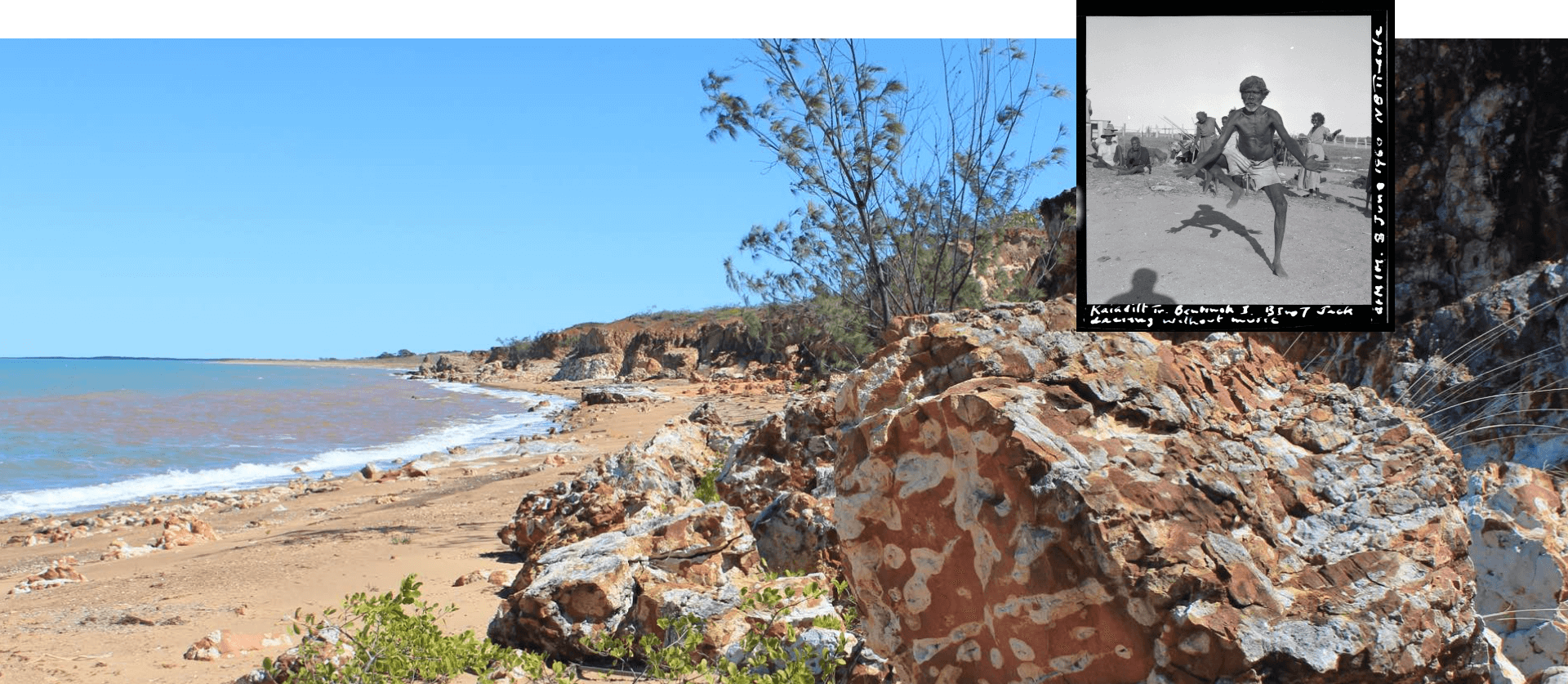
Sally Gabori painting. © Inge Cooper
Mirdidingkingathi Juwarnda Sally Gabori is an Aboriginal artist who began painting at the age of 81. Over ten years, she produced several thousand paintings, although her culture had little to no graphic tradition.
Her paint was her island, her family, and her language, Kayardild. A place she left in 1946, expelled by Australian colonists. Her birthplace, Bentinck Island, is now uninhabited. Her ancestors had lived there for generations.

Bentinck Island © Dan Rosendahl
Traditional Kaiadilt dance, photographed by Australian anthropologist Norman Tindale. Mornington Island Presbyterian Mission 1960 © South Australian Museum archives
In April 2022, the Fondation Cartier, represented by Johanna Musch and Ana Gluschankof, offered us the opportunity to design a companion project to the exhibition: a non-linear, sparsely narrated, searchable resource base. In strict terms, a web documentary. What’s the right approach? How to best accompany the discovery of these works, displayed for the first time outside of Australia?

The Database as a Starting Point
Upon receiving media, the first reflex is to classify, thematize, describe, and caption the audio, video, paintings, landscapes and maps collected by the Fondation. The site will remain after the exhibition ends; therefore its role is to accompany the event while also keeping record for the long term. This works out well, we’re very interested by the concept of passing on heritage.
By providing a few reading keys and juxtaposing these with media, we might just be able to make something interesting.
The images pull us into this place, situated north of Australia in the gulf of Carpentaria: sandbanks, mangroves, narrow waterways, freshwater lagoons, and water lilies.
Sally’s work, her story, and her legacy function as a harmonious whole.
Painting, however, is often mysterious. We can weave links, yes, but shouldn’t we also leave space?
When we place two images next to each other, the mind can’t help but create a story; that’s the magic of the ellipsis. As viewers, it’s what makes us invested.
We’re going to create sequences without explaining why these images and videos are adjacent to one another. We’re establishing a few rules of association (kept secret within the lines of code). If there are as many interpretations as there are observers, there will be as much media as there are sequences. Each click generates a different slideshow.

The site’s content is condensed on an immense data table, an information collection and acquisition project led by the Fondation Cartier which encompasses more than 200 media (therefore, 200 stories).

Chance and Curiosity
The idea, as you may have guessed, is to center the site’s consultation around chance.
A color picked at random from Sally’s palette for the introduction, a video clip of the artist painting, drawn by chance, in the timeline. Before accessing navigation, a long zoom on the map with the exhibit’s key regions.
There are 3 ways to approach the site:
• By map region: here, the sequence order is pre-established, the paintings mingle with timelapses of landscapes and audio clips. It’s the most classic approach.
• In the menu to the left, access to paintings, archival images, and videos produced by the Fondation. Selecting a media starts a sequence generated by the database.
• Through search: for those already familiar with this work.
The Project Team
Antoine Abbou is the great architect of the site’s structure. Content management is administered through Airtable (a sort of upgraded spreadsheet). On mobile, all content is accessible except map navigation (either the screen is too small, or fingers are too big – your choice).
Baptiste Duchêne upholds the editorial vision, under the direction of Thomas Deyriès and Gregory Trowbridge: the placement of soundscapes, attending to the mechanics of « stories: » sequencing such different sources, in multiple languages, requires careful attention to all the small details.
Sébastien Brothier, Ellie Orain, Maëlle Rabouan and Marie Civitello provide backup.
Our secret hope is that visitors to the exhibit (a kiosk is available on site) as well as web users explore the connections between this painting and all the rest: the colors which recall the changing shades of the sky, or the glittering rings that evoke the sight of codfish passing below the water’s surface.
Thank you to the Fondation team: Alessia, Ana, Isabelle, Johanna, Juliette, Naïa, Nick, Valentin, and Solène for their trust.















